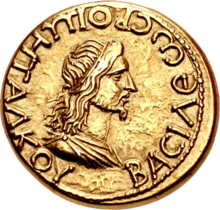| T. J. Cotys II | |
|---|---|
 Gold stater of the Bosporan king Cotys II, legend BACΙΛΕΩC ΡΟΙΜΗΤΑΛΚΟΥ. (Οther side: head of Hadrian, year ΥΚΓ΄ = 423 = 126/7) 19 mm, 7.78 g. | |
| King of the Bosporus | |
| Reign | 123 - 131 |
| Predecessor | T. J. Sauromates I |
| Successor | T. J. Rhoemetalces |
| Died | 131 |
| Issue | T. J. Rhoemetalces T. J. Eupator |
| Dynasty | Tiberian-Julian |
| Father | T. J. Sauromates I |
Cotys II or Kotys II (Greek: Τιβέριος Ἰούλιος Κότυς Β' Φιλοκαῖσαρ Φιλορωμαῖος Eὐσεβής, Tiberios Iulios Kotys Philocaesar Philoromaios Eusebes, flourished 2nd century, died 131) was a prince and Roman client king of the Bosporan Kingdom. Like many other later Bosporan kings, Cotys II is known mainly from coinage, alongside a few inscriptions and contemporary writings. His coins are known from the period 123–131.[1] Cotys II is known to have been the son of his predecessor Sauromates I.[2] His relationship to later kings is not known for certain, but it is possible that his two immediate successors Rhoemetalces and Eupator were his sons.[2]
During his reign, the city of Chersonesus Taurica was under his direct control. Cotys II is mentioned in the writings of the Roman Historian Arrian and was a contemporary to the rule of the Roman emperor Hadrian.
See also
Sources
- ^ Mitchiner, Michael (1978). The Ancient & Classical World, 600 B.C.-A.D. 650. Hawkins Publications. p. 69. ISBN 978-0-904173-16-1.
- ^ a b Settipani, Christian (2006). Continuité des élites à Byzance durant les siècles obscurs: les princes caucasiens et l'Empire du VI:e au IX:e siècle (in French). Paris: De Boccard. p. 408. ISBN 978-2-7018-0226-8.
- Encyclopedia of ancient Greece By Nigel Guy Wilson Edition: illustrated Published by Routledge, 2006 ISBN 0-415-97334-1, ISBN 978-0-415-97334-2
